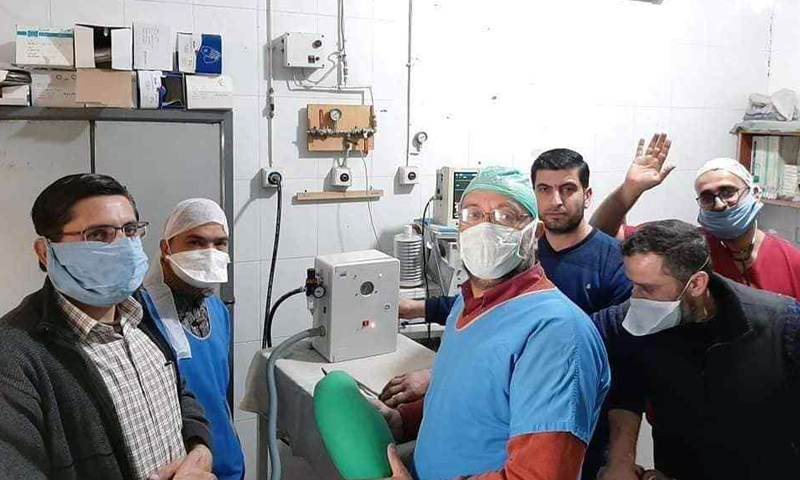



Enab Baladi – al-Bab
Engineers and doctors in the opposition-held city of al-Bab, eastern Aleppo, have managed to build a medical ventilator machine, for possible future need in the region, amid the spread of the novel coronavirus (COVID-19) pandemic.
A team of engineers, a doctor, and an anesthesiologist have worked on the production of the locally-made machine, as a preventive measure to supply medical centers before the arrival of the virus to the area.
Ahmed al-Jabali, who came up with the idea and is a participant in constructing the device, told Enab Baladi, that the specialized team can produce more than 100 ventilators weekly with the involvement of a cooperating team from the Vocational Training Institute For Alternative Energy of the educational directorate in al-Bab city.
Al-Jabali added that the manufacturing of this quantity would not start unless the region needs these respiratory devices in the upcoming period; meanwhile, the ventilator’s production is currently reduced to limited numbers as a precautionary measure before the arrival of the coronavirus pandemic.
As for the materials used in building the machine, which was produced by a group of electrical engineers, a surgeon, and an anesthesiologist, are available in the local markets, including electrical tools and spare parts, making the cost of the ventilator device less than 120 US dollars (USD), according to al-Jabali.
The specialists tried their prototype ventilator on an artificial lung, then on four patients, where the device had proven effective without any technical or medical problems.
In an interview with Enab Baladi, Ahmed al-Abo, the head of the medical office of the al-Bab local council, said that the device is designed on the ambulatory basis just like the ones used in ambulances (portable ventilators), delivering breathable air into and out of the patient’s lung until placed on the full ventilator breathing system.
The ambulatory-designed device consists of airflow sensors for the patient’s lung pressure and pressure given by the ventilator, along with a safety sensor to monitor the patient’s breathing (airflow rate). It is worth mentioning that the device has no validity period and serves for a long time.
Nevertheless, hospital ventilators monitor the breathing rate—the volume of air entering and moving out from the lungs—and the percentage of oxygen saturation levels.
The total number of ventilators available in the hospitals of northern Syria amounts to 98: 47 adult ventilators in Idlib and 54 ventilators in Aleppo, according to the ministry of health of the Syrian’s opposition’s Interim Government (SIG)
In an interview with Enab Baladi, the SIG’s health minister, Doctor Maram al-Sheikh, said that the ministry is working on a project to provide the “liberated” Syrian north with medical ventilators through the “Credit Fund,” as well as efforts by humanitarian organizations, volunteers, and donors.
The World Health Organization (WHO) has also promised to provide northern Syrian with 90 ventilation devices, as everyone in the north is working on increasing the number of ventilators, according to al-Sheikh.
The minister pointed out that numbers of medical ventilators should be in conformity with the available human capacity, “for the technicians can only run a limited number of ventilation devices.”
Therefore, increasing the number of devices to the extent that the available medical staff can operate them is considered good; however, surplus machines may not be helpful.
A ventilator is a machine that provides artificial ventilation by pumping or blowing oxygen-rich air and removing carbon dioxide from the patient’s lungs, thus helping people with severe cases who cannot breathe on their own. ventilation devices can save a patient’s life when the person cannot breathe properly, or when the patient cannot breathe alone at all.
Moreover, the device is not intended to be a cure for diseases but used instead during treatment to stabilize the patient’s condition. It allows patients whose respiratory capacity has been reduced to stay alive and has proven effective and reliable amid the coronavirus pandemic.
Ventilators have helped many coronavirus-patients to stay alive by providing additional time for the immune system to fight the virus.
According to the WHO, one out of six COVID-19 patients becomes seriously ill and has difficulty breathing.
if you think the article contain wrong information or you have additional details Send Correction